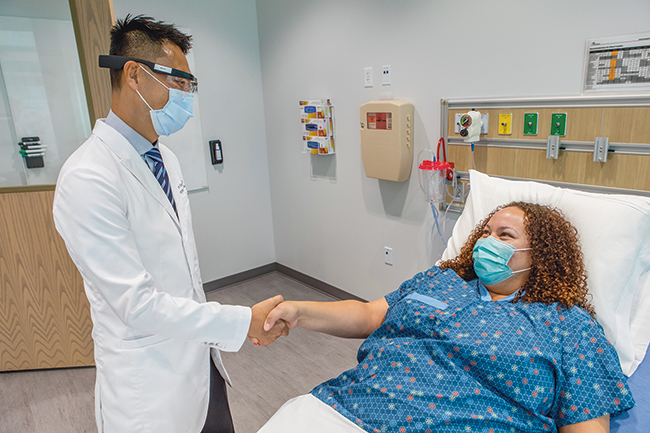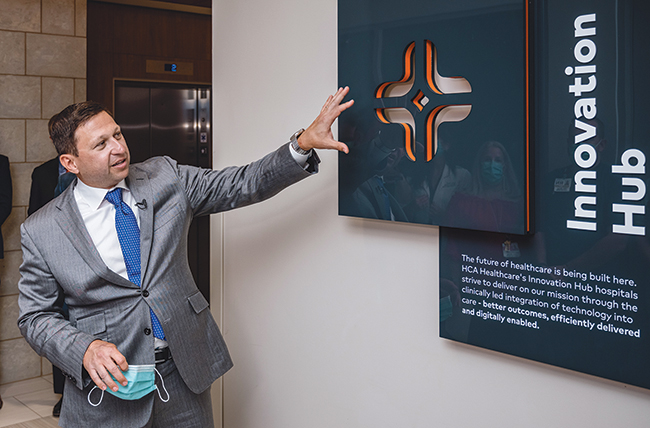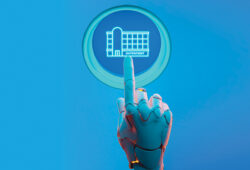HCA Healthcare is proving the future is now
It’s rare to find a hospital staff member who is not strapped for time. There are always patients to see, charts to complete, family questions to answer, orders to review and medications to dispense. Add the focus on ensuring quality care and the current labor challenges throughout the healthcare industry, and you have healthcare professionals who are maxed out.
But smart technology is rising to help meet these challenges. More hospitals are evolving to incorporate data and smart systems, allowing providers to improve patient care and experience, while lowering costs and reducing reliance on manual efforts. (McKinsey found that using digital technologies in healthcare delivery can decrease annual national healthcare expenses by more than 10%.)
As the COVID pandemic further revealed the need for smart solutions, digital health startups raised $29.1 billion in 2021—more than twice what was raised the year before.
The move to smarter hospitals is seemingly inevitable. But what will it take to get there? HCA Healthcare is showing this path to the future with its initiatives in smart hospital innovation.

Leveraging technology for better care
In July 2021, HCA Healthcare launched a new department within its Clinical Services Group (CSG) called Care Transformation and Innovation (CT&I) to accelerate the integration of technology into patient care. Its vision involves clinicians, data and machine learning (ML) to explore innovations that will address problems in future healthcare delivery. CT&I brings together clinical staff, data science, engineering, technology, operations, change management and finance personnel to “be boldly innovative and design the future of patient-centered care.”
CT&I at HCA Healthcare is led by Mike Schlosser, M.D., MBA, SVP of Care Transformation and Innovation. Below he shares some of his organization’s efforts to bring smart technology into practice.
Clinical initiatives: CT&I found that the labor and delivery space was a good starting point, offering ways to improve outcomes. This was an opportunity to continue innovating in maternal and fetal well-being, following a successful clinical project, 39 Weeks (see more about HCA Healthcare’s legacy of labor and delivery work in the sidebar below). In another initiative, SPOT (sepsis prediction and optimization of therapy), clinical staff teamed up with data scientists, researchers and process improvement experts to develop a predictive algorithm to more quickly detect sepsis.
Staff scheduling: As a pilot project, HCA Healthcare focused on staff scheduling. The Staff Scheduler program uses an ML demand forecast algorithm to predict staffing needs, measures the complexity of different procedures, and then optimizes staffing according to nurses’ proficiencies and schedule preferences. The goal is to have the right staff members in the right places, at the right time, to deliver the best care possible for patients. “Since we began to pilot Staff Scheduler, we’re already seeing significant time savings, improvements in nurse satisfaction and, importantly, optimized staffing to meet patient demand and needs,” Dr. Schlosser shares.
Automation: HCA Healthcare is also working to automate manual efforts to save staff time and focus on patient care, the real reason care team members were inspired to go into healthcare. One of the major pain points for the healthcare system’s care team members is the amount of time required at the keyboard. The organization is looking into solutions where they can connect systems to automatically transfer information, reducing the need for staff to enter data into the electronic health record and just approve and/or edit the information.
Smart eyewear: HCA Healthcare’s UCF Lake Nona Hospital in Orlando, Florida, is conducting an advanced technology pilot, which involves physicians donning technology-embedded eyeglasses. With a patient’s consent, the voice-recognition technology records their interaction with a physician to automate charting. The conversation is transcribed from the recording, and the physician reviews, edits and approves it, improving efficiencies in charting from scratch. “While this innovation is still developing in collaboration with Emergency Department physician leadership, there will always be a human element in the documentation process. It’s an area we’re working on to leverage technology to make our clinicians’ lives easier and patient experiences better,” Dr. Schlosser explains.

Google Cloud partnership: HCA Healthcare partnered with Google Cloud to gain actionable insights and improve workflows. “With privacy and security as a guiding principle, our data platform is aimed at empowering physicians, nurses and others with workflow tools, analysis and alerts on their mobile devices to help them respond quickly to changes in a patient’s condition,” Dr. Schlosser says. “My ultimate goal is to provide a technology-driven clinical experience that makes our hospitals a destination for care, affording team members the ability to operate at the top of their license and be the destination for patients who want the highest quality care.”
Additional advances
Some hospitals are adopting radiofrequency identification (RFID) bar codes to track supplies and equipment. RFID codes can be scanned in a supply room or operating room to help automate the supply replenishment process and track supply and usage status in real time. Some hospitals use robots to deliver supplies or remove trash and recycling, freeing up precious human labor to do more impactful work. Artificial intelligence (AI)-enabled radiology software can triage imaging studies to alert staff to a higher priority case, and indicate potential diagnoses to highlight concerns. When suggesting a diagnosis or identifying anomalies, the software can have rates for accuracy equal to that of physician diagnostic rates. While certainly improving patient care, it also optimizes a radiologist’s workflow.
Bed alarms are an important fall-prevention technology. They are set off if a patient starts moving in bed, immediately alerting hospital staff. Virtual sitters are a relatively new form of technology that allow healthcare professionals to remotely monitor patients who are a fall risk. The technology uses infrared sensors to detect a patient’s movement. This form of remote patient monitoring requires just one nurse to monitor a group of patients via video, enabling better oversight of patient needs. If a patient falls, that nurse can more quickly summon a bedside aide or nurse to assist.
The nurse doing the video monitoring can also answer questions that don’t require a floor nurse to make a special trip into the room, diverting time from other care. In-room monitors can also be used to allow family members to participate in medical discussions remotely and be part of the care. These video systems are often used to provide hospital-approved education to reinforce in-person teaching about health conditions, treatments, medications and post-discharge care.
Smart hospitals’ impact on payor models
The U.S. healthcare system has been shifting to a value-based care model for years. Many payors, private and public, use some form of value-based care in payment models. These include incentive payments for quality of care and penalties for issues like unplanned readmissions. Tracking and analyzing data can help hospital leaders understand what might be affecting quality. It can also help them determine what types of smart technology will support patient care and, in turn, improve quality.
Sharing data in a HIPAA- and legally compliant way with a hospital’s network is also more manageable in a smart hospital environment. As healthcare organizations continue consolidating, whether it be hospitals, clinics, labs or a combination, greater opportunities exist to use the accessible data to improve care for an individual patient. It can help providers avoid duplicating tests, better understand the patient’s current and past health issues and treatments, and offer more information that assists in connecting the dots when making a diagnosis.

The data can also be used on a population health level, to understand factors contributing to various diseases and treatments. This allows a hospital to support its community with outreach and preventive care for specific issues. It can also support individual patients in their health journeys, using the population health analytics to discern which patients may respond to a specific treatment, or how to assist a patient leaving the hospital in lining up the appropriate aftercare.
Smart hospitals will also be able to reduce errors. Diagnostic errors contribute to an estimated 10% of patient deaths. Software already exists that incorporates AI, alerting clinicians to potential diagnoses like a stroke or tumor that even a well-trained human eye might miss. It’s similar to a lab report showing an out-of-reference range. It calls attention to the abnormality, potentially triaging it so the clinician sees it sooner.
The future is now
Becoming a smart hospital involves experts from throughout an organization, from IT, process improvement and human resources to clinicians, service line leaders and supply chain. This innovative way of integrating patient care and hospital workflows can transform the inner workings of a single department or an entire health system. And, whatever levels of technology are implemented, the outcomes are clear—patients and clinicians stand to benefit from the results.
- In the early 2000s, the March of Dimes approached HCA Healthcare to research the connection between elective delivery before 39 weeks and the need for Neonatal Intensive Care Unit (NICU) services. HCA Healthcare’s assessment of data from 27 hospitals and 18,000 deliveries over three months affirmed the increased rate of NICU usage for deliveries at less than 39 weeks. This led to a worldwide standard: No elective deliveries before 39 weeks.
- Through extensive research of HCA Healthcare’s databases of nearly 100,000 inductions when oxytocin was administered in its facilities, the company was able to standardize how oxytocin is administered and decrease the likelihood of Caesarean section, NICU admission and postpartum hemorrhage.
- HCA Healthcare’s Henrico Doctors’ Hospital and CT&I are collaborating with GE Healthcare in deploying its Mural Solution for Labor and Delivery technology. This enables real-time data mining from any medical technology (e.g., blood pressure machine, fetal heart pump, IV pump), that’s connected to a hospital’s network. All maternity patients are connected to this technology and their blood pressure is continually monitored. Already, CT&I and Henrico are seeing the technology’s positive impact on patient safety by reducing the median time to get blood pressure medication to hypertensive patients.






